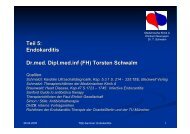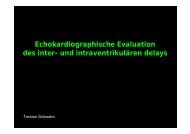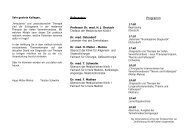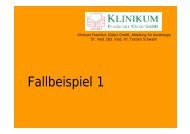Zunahme der IMD - von Torsten Schwalm
Zunahme der IMD - von Torsten Schwalm
Zunahme der IMD - von Torsten Schwalm
Sie wollen auch ein ePaper? Erhöhen Sie die Reichweite Ihrer Titel.
YUMPU macht aus Druck-PDFs automatisch weboptimierte ePaper, die Google liebt.
Stellenwert <strong>der</strong> Intima-Media-Dicke<br />
- als screening - Werkzeug<br />
- als prognostischer Parameter<br />
…. <strong>der</strong> Arteriosklerose<br />
<strong>Torsten</strong> <strong>Schwalm</strong>
Die Intima-Media-Dicke: Anatomie<br />
Hochauflösen<strong>der</strong> Ultraschall <strong>der</strong> Hinterwand <strong>der</strong><br />
Arteria carotis communis mit 9 Mhz Ultraschallsonde
Die Intima-Media-Dicke: Pathologie
Die Intima-Media-Dicke: Messung<br />
- Natürliche <strong>Zunahme</strong> <strong>der</strong> <strong>IMD</strong> um 0,04 mm / 10 Jahre<br />
-Normwerte:<br />
< 40. LJ < 0,6 mm<br />
40.-60. L < 0,8 mm<br />
> 60. LJ < 1 mm
Stellenwert <strong>der</strong> Intima-Media-Dicke<br />
als atherothrombotischer Risikofaktor<br />
Klassische Risikofaktoren<br />
Adipositas<br />
KHK in <strong>der</strong> Familienanamnese<br />
Diabetes<br />
Lebensstilfaktoren<br />
Hyperlipidämie<br />
Hyperkoagulabilität<br />
Hypertonie<br />
Geschlecht<br />
Alter<br />
Risikofaktoren<br />
Neue Risikofaktoren<br />
Prothrombotische Faktoren:<br />
Fibrinogen, hs CRP, PAI-1<br />
<strong>Zunahme</strong> <strong>der</strong> <strong>IMD</strong><br />
Genetische<br />
Merkmale<br />
Atherothrombotische Anamnese<br />
Vorhergehen<strong>der</strong> MI<br />
Vorhergehen<strong>der</strong> Schlaganfall<br />
Instabile Angina pectoris<br />
TIA<br />
Stabile Angina pectoris<br />
PAVK
Stellenwert <strong>der</strong> Intima-Media-Dicke<br />
als screening-Werkzeug<br />
- Relativ linearer Anstieg im Verhältnis zur Ausprägung / Vorhandensein <strong>von</strong><br />
Risikofaktoren, z.B. Cholesterinspiegel, BMI, Rauchen, arterielle Hypertonie 1,2,3<br />
-„Screening“-Methode, Evaluation neuer Risikofaktoren, ggf. frühzeitige<br />
Beeinflussung des Risikoprofils.<br />
- <strong>IMD</strong> stellt einen Spiegel <strong>der</strong> arteriosklerotischen Last dar und ist ein<br />
guter Prädiktor, wie traditionelle Risikofaktoren, eines zukünftig eintretenden<br />
ischämischen Ereignisses<br />
1 Markus RA et al. Influence of lifetstyle modification on atherosclerotic progression determined by ultrasonographic change in<br />
ACC thickness. Am J Clin Nutr 1997;65:1000-5 2 Poredos P et al. Smoking is associated with dose-related increase in IMT and<br />
Endothelial dysfunction. Angiology 1999;50:201-8 3 Zizek B et al. Dependence of morphological changes of the carotid arteries on<br />
essential hypertension and accompanying risk factors. Int Angiol 2002;21:70-7.
Stellenwert <strong>der</strong> Intima-Media-Dicke:<br />
hat prognostische Relevanz<br />
- Für jede Steigerung <strong>der</strong> <strong>IMD</strong> um 0,1 mm steigt das Risiko eines MACE um 11% 1<br />
- Bei einer <strong>IMD</strong> > 1mm besteht ein doppelt erhöhtes MACE-Risiko innerhalb <strong>von</strong> 2<br />
Jahren 1<br />
- Bei einer <strong>IMD</strong> > 1mm besteht ein vierfach erhöhtes Risiko eines MACE o<strong>der</strong><br />
Schlaganfalls innerhalb <strong>von</strong> 6 Jahren 2<br />
1 Salonen JT et al. Ultrasound imaging in observational studies of atherosclerotic progression. Circulation 1993;87: 1156-65<br />
2 O`Leary DH et al. IMT as a risk factor for myocardial infarction and stroke in ol<strong>der</strong> adults. N Engl J Med 1999;340:14-22
Stellenwert <strong>der</strong> Intima-Media-Dicke<br />
Pharmakotherapie<br />
- Hemmung <strong>der</strong> <strong>IMD</strong> - <strong>Zunahme</strong> durch Statine 1-6, aber auch Calciumantagonisten 8 ,<br />
Sartane und Betablocker 7<br />
1 Salonen R et ak.A population-based primary preventive trial of the effect of LDL lowering on atherosclerotic progression in<br />
carotid and femoral arteries.Circulation 1995, 92:1758-1764. 2 Crouse JR et al. Pravastatin, lipids, and atherosclerosis in the<br />
carotid arteries (PLAC-II). Am J Cardiol 1995, 75:455-459. 3 Mercuri M et al. Pravastatin reduces carotid intima-media thickness<br />
progression in an asymptomatic hypercholesterolemic Mediterranean population: the Carotid Atherosclerosis Italian Ultrasound<br />
Study. Am J Med 1996, 101:627-634. 4 De Groot E et al.B-mode ultrasound assessment of pravastatin treatment effect on carotid<br />
and femoral artery walls and its correlations with coronary angiographic findings: a report of the Regression Growth Evaluation<br />
Statin Study (REGRESS).J Am Coll Cardiol 1998, 31:1561-1567. 5 Hedblad B et al.Low-dose metoprolol CR/XL and fluvastatin slow<br />
progression of carotid intima-media thickness.Circulation 2001, 103:1721-1726. 6 Sawayama Y et al.Effects of probucol and<br />
pravastatin on common carotid atherosclerosis in patients with asymptomatic hypercholesterolemia. J Am Coll Cardiol 2002,<br />
39:610-616. 7 Multicentre Olmesartan atherosclerosis regression evaluation; Stumpe K.O. et al.Therapeutic advances in<br />
cardiovascular diseases 2007;1: 97-106. 8 Pitt B et al. Effect of amlodipine on the progression of atherosclerosis and the<br />
occurence of clinical events. Circulation 2000;102:1503-1510
Stellenwert <strong>der</strong> Intima-Media-Dicke<br />
Limitationen<br />
- Zweidimensionales Verfahren, evaluiert nur für den Gefässabschnitt <strong>der</strong> Arteria carotis<br />
communis<br />
- Eine Abgrenzung zwischen Lipideinlagerungen sub-intimal als Manifestation <strong>der</strong><br />
Arteriosklerose und hypertrophierter Media als Zeichen Anpassung an erhöhten<br />
Blutdruck („Media-Remodelling *) gelingt nicht, beide Schichten werden gemeinsam<br />
vermessen.<br />
* Chobanian, A.V. Adaptive and maladaptive response of the arterial wall to hypertension. Hypertension 1990; 15:666-746.
Stellenwert <strong>der</strong> Intima-Media-Dicke<br />
Perspektiven<br />
- Erweiterung des Verfahrens durch 3-dimensionalen Gefässultraschall, Detektion <strong>der</strong><br />
kompletten Gefässwand zur besseren Analyse <strong>von</strong> Plaquelast und –struktur<br />
- Dabei erstmals Nachweis einer Regression des Plaquevolumens durch den<br />
AT-1 Blocker Olmesartan Medoxomil *<br />
- Mögliche antiatherogene Wirkung über das Mass <strong>der</strong> Blutdrucksenkung<br />
hinaus!<br />
* Multicentre Olmesartan atherosclerosis regression evaluation; Stumpe K.O. et al.Therapeutic advances in cardiovascular diseases<br />
2007;1: 97-106.
Fazit<br />
Der Stellenwert <strong>der</strong> Intima-Media-Dicke…<br />
ist etabliert in den Leitlinien…..<br />
u.a. 2007 <strong>der</strong> Europäischen Gesellschaft für Hypertonie und Kardiologie *<br />
als unabhängiger Risikofaktor,<br />
als screening – Werkzeug,<br />
als prognostischer Parameter,<br />
und als Messwert einer antiatherosklerotischen Therapie,<br />
eine Erweiterung stellt die 3-D-Analyse <strong>der</strong> Plaquelast dar.<br />
* Journal of Hypertension, 2007:25:1105-1187
Vielen Dank für Ihre Aufmerksamkeit !











